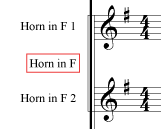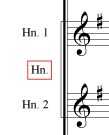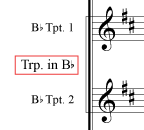Complex Type: part-group
Description
The part-group element indicates groupings of parts in the score, usually indicated by braces and brackets. Braces that are used for multi-staff parts should be defined in the attributes element for that part. The part-group start element appears before the first score-part in the group. The part-group stop element appears after the last score-part in the group. The number attribute is used to distinguish overlapping and nested part-groups, not the sequence of groups. As with parts, groups can have a name and abbreviation. Values for the child elements are ignored at the stop of a group. A part-group element is not needed for a single multi-staff part. By default, multi-staff parts include a brace symbol and (if appropriate given the bar-style) common barlines. The symbol formatting for a multi-staff part can be more fully specified using the part-symbol element.
Derived By
Restricting xs:anyType
Attributes
| Name | Type | Required? | Default | Description |
|---|---|---|---|---|
| type | start-stop | Yes |
|
|
| number | xs:token | No | 1 | The number attribute is used to distinguish overlapping and nested part-groups, not the sequence of groups. |
Content Model
Contains elements as defined in the following table.
| Component | Type | Occurs | Default | Description |
|---|---|---|---|---|
 |
1..1 |
|
||
| group-name | group-name | 0..1 |

The group-name type describes the name or abbreviation of a part-group element. Formatting attributes in the group-name type are deprecated in Version 2.0 in favor of the new group-name-display and group-abbreviation-display elements. |
|
| group-name-display | name-display | 0..1 |

Formatting specified in the group-name-display element overrides formatting specified in the group-name element. |
|
| group-abbreviation | group-name | 0..1 |

Formatting specified in the group-abbreviation-display element overrides formatting specified in the group-abbreviation element. |
|
| group-abbreviation-display | name-display | 0..1 |

Formatting specified in the group-abbreviation-display element overrides formatting specified in the group-abbreviation element. |
|
| group-symbol | group-symbol | 0..1 |

The group-symbol type indicates how the symbol for a group is indicated in the score. |
|
| group-barline | group-barline | 0..1 |

The group-barline type indicates if the group should have common barlines. |
|
| group-time | empty | 0..1 |

The group-time element indicates that the displayed time signatures should stretch across all parts and staves in the group. |
|
 |
0..1 |
|
||
| footnote | formatted-text | 1..1 | The footnote element specifies editorial information that appears in footnotes in the printed score. It is defined within a group due to its multiple uses within the MusicXML schema. |
|
 |
0..1 |
|
||
| level | level | 1..1 | The level type is used to specify editorial information for different MusicXML elements. |
|
Referenced By
- Element part-group
Definition
<xs:complexType name="part-group">
<xs:annotation>
<xs:documentation>The part-group element indicates groupings of parts in the score, usually indicated by braces and brackets. Braces that are used for multi-staff parts should be defined in the attributes element for that part. The part-group start element appears before the first score-part in the group. The part-group stop element appears after the last score-part in the group.
The number attribute is used to distinguish overlapping and nested part-groups, not the sequence of groups. As with parts, groups can have a name and abbreviation. Values for the child elements are ignored at the stop of a group.
A part-group element is not needed for a single multi-staff part. By default, multi-staff parts include a brace symbol and (if appropriate given the bar-style) common barlines. The symbol formatting for a multi-staff part can be more fully specified using the part-symbol element.</xs:documentation>
</xs:annotation>
<xs:sequence>
<xs:element name="group-name" type="group-name" minOccurs="0">
<xsd:annotation>
<xsd:documentation>The group-name type describes the name or abbreviation of a part-group element. Formatting attributes in the group-name type are deprecated in Version 2.0 in favor of the new group-name-display and group-abbreviation-display elements.</xsd:documentation>
</xsd:annotation>
</xs:element>
<xs:element name="group-name-display" type="name-display" minOccurs="0">
<xs:annotation>
<xs:documentation>Formatting specified in the group-name-display element overrides formatting specified in the group-name element.</xs:documentation>
</xs:annotation>
</xs:element>
<xs:element name="group-abbreviation" type="group-name" minOccurs="0">
<xsd:annotation>
<xsd:documentation>Formatting specified in the group-abbreviation-display element overrides formatting specified in the group-abbreviation element.</xsd:documentation>
</xsd:annotation>
</xs:element>
<xs:element name="group-abbreviation-display" type="name-display" minOccurs="0">
<xs:annotation>
<xs:documentation>Formatting specified in the group-abbreviation-display element overrides formatting specified in the group-abbreviation element.</xs:documentation>
</xs:annotation>
</xs:element>
<xs:element name="group-symbol" type="group-symbol" minOccurs="0">
<xsd:annotation>
<xsd:documentation>The group-symbol type indicates how the symbol for a group is indicated in the score.</xsd:documentation>
</xsd:annotation>
</xs:element>
<xs:element name="group-barline" type="group-barline" minOccurs="0">
<xsd:annotation>
<xsd:documentation>The group-barline type indicates if the group should have common barlines.</xsd:documentation>
</xsd:annotation>
</xs:element>
<xs:element name="group-time" type="empty" minOccurs="0">
<xs:annotation>
<xs:documentation>The group-time element indicates that the displayed time signatures should stretch across all parts and staves in the group.</xs:documentation>
</xs:annotation>
</xs:element>
<xs:group ref="editorial" />
</xs:sequence>
<xs:attribute name="type" type="start-stop" use="required">
<xsd:annotation>
<xsd:documentation>
</xsd:documentation>
</xsd:annotation>
</xs:attribute>
<xs:attribute name="number" type="xs:token" default="1">
<xsd:annotation>
<xsd:documentation>
</xsd:documentation>
</xsd:annotation>
</xs:attribute>
</xs:complexType>
